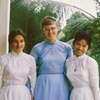Peace and Service in Vietnam
Profiles and Reflections

Doug Hostetter: Mennonite Central Committee/Vietnam Christian Service, Tam Ky, Vietnam

Paul Leatherman: Mennonite Central Committee/Vietnam Christian Service, Saigon, Vietnam

Roger Marshall: Quaker Rehabilitation Center, Quang Ngai, Vietnam

Marjorie Nelson: Quaker Rehabilitation Center, Quang Ngai, Vietnam

Ted Studebaker: Brethren Volunteer Service/Church World Service/Vietnam Christian Service, Di Linh,  Vietnam
Vietnam

Dorothy Weller: Quaker Rehabilitation Center, Quang Ngai, Vietnam
Introduction and Background
During the Vietnam War, 170,000 young men in the U.S. received conscientious objector deferments, and performed alternative service rather than going to war as soldiers. A small number of these men, along with others who wanted to contribute to the peace and well-being of Vietnam through peaceful means, did their service in South Vietnam.
Vietnam was divided between North and South during the war with the U.S. supporting the Saigon government in the South.
While Quakers and Mennonites made contact with the North Vietnamese and the National Liberation Front* in the South, nearly all of their assistance went to people living in the Saigon government-controlled areas of South Vietnam. The ship Phoenix, sponsored by A Quaker Action Group, made three voyages, delivering medical aid to North Vietnam, the National Liberation Front, and Saigon-controlled areas of South Vietnam.
Vietnam was an intense and challenging context for conscientious objectors and others who chose to offer their skills and build relationships midst the violence and human suffering of war. In the profiles and reflections of six civilians presented below, you will find struggles of identity, faith, security, individual witness and citizenship.
Impressions of the war varied widely, depending on the region, the time-period in Vietnam and the strength of relationships within a given community. These stories of Vietnam Christian Service and Quaker Service Vietnam workers offer a small window into a broad and complex set of experiences, told in much greater detail in other sources.
Please note the additional resource list below if you would like to learn more.
*National Liberation Front: Vietnamese political and military organization dedicated to the overthrow of the South Vietnamese government and the reuinifcation of North and South Vietnam.
Additional Resources
See Peace & Change: A Journal of Peace Research, vol. 27, no. 2 (April 2002). Special Issue on Non-Governmental Organizations and the Vietnam War.
--Delia Pergande, “Private Voluntary Aid and Nation Building in South Vietnam: The Humanitarian Politics of Care, 1954-61,” pp. 165-97.
--Perry Bush, “The Political Education of Vietnam Christian Service, 1954-1975,” pp. 198-224.
--Paul A. Rodell, “International Voluntary Services in Vietnam: War and the Birth of Activism, 1958-1967,” pp. 225-44.
--Scott Flipse, “The Latest Casualty of War: Catholic Relief Services, Humanitarianism, and the War in Vietnam, 1967-1968,” pp. 245-70.
--Jill K. Gill, “The Political Price of Prophetic Leadership: The National Council of Churches and the Vietnam War,” pp. 271-300.
See Midge Austin Meinertz, Vietnam Christian Service: Witness in Anguish, Church World Service, 1976.
See Atlee and Winifred Beechy, Vietnam: Who Cares? Herald Press, Scottdale, Pennsylvania, 1968.
See Omar Eby, "A house in hue," Herald Press, Scottdale, PA, 1968.
See Earl Martin, "Reaching the Other Side," Crown Publishers, New York, 1978.